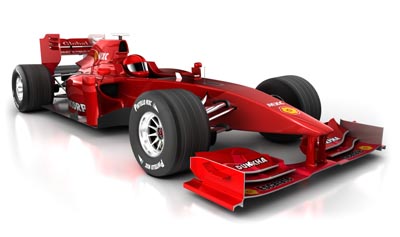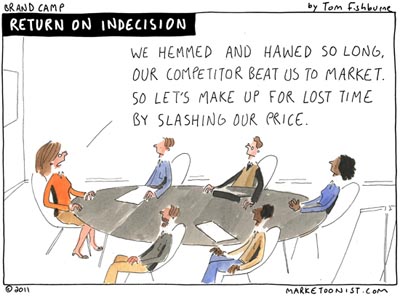Most business leaders subscribe to the theory of first mover advantage: being first to market results in competitive advantages in sales and market share (#2  loses 25% of sales to #1), earnings (late to market cuts 5-year profitability by a third) and others. Just ask Samsung how it feels to be #2 behind the iPad or try going head to head with Lunchables in the kids carried lunch category that continues to bolster their #1 position with cool new product introductions. There are some contrary points of view emanating from the high tech industry, but in most others being first is usually preferred over the hope that your late entry is one of the exceptions.
loses 25% of sales to #1), earnings (late to market cuts 5-year profitability by a third) and others. Just ask Samsung how it feels to be #2 behind the iPad or try going head to head with Lunchables in the kids carried lunch category that continues to bolster their #1 position with cool new product introductions. There are some contrary points of view emanating from the high tech industry, but in most others being first is usually preferred over the hope that your late entry is one of the exceptions.
But assuming you have the idea in the first place, seizing first mover advantage requires you to have an accelerated Idea to Market™ process; one that gets to market fast but doesn’t substantially increase risk. Here are three principles for driving speed without substantially increasing risk.
Clarity vs. Clutter
At a major global CPG firm, we did a study of the key attributes of projects that got to market fast vs. those that languished and seemed to take forever. Key enabler of speed: strategic clarity. Senior leadership visibility and understanding of the strategic product, technology and supply chain roadmaps and how it fit into the overall innovation and business strategies facilitated improvements in time to market by as much as 40%. By contrast, those projects that lacked clarity had decision-making processes cluttered with competing agendas and points of view, each with their own supporting “facts” that had to be waded through to get to a decision that was often a long time in the making.
enabler of speed: strategic clarity. Senior leadership visibility and understanding of the strategic product, technology and supply chain roadmaps and how it fit into the overall innovation and business strategies facilitated improvements in time to market by as much as 40%. By contrast, those projects that lacked clarity had decision-making processes cluttered with competing agendas and points of view, each with their own supporting “facts” that had to be waded through to get to a decision that was often a long time in the making.
Core vs. Context
You’ve maybe heard it or said it yourself: “This [work] is not what I went to [insert expensive MBA or grad school at prestigious university] to do. And you were probably right. In one such work analysis, we found a typical brand manager spent 3x more time in the financial planning processes than the marketing and new product processes combined. In every job, whether it’s marketing, R&D or whatever, there is work that can be defined as “core” to the job. Everything else is either “context” (necessary to get done but not core to the job) or just waste. For example, developing your new product’s go-to-market strategy is core but managing the master data associated with a new product is context… needs to be done but not why a brand manager was hired. We find an average of 60% of the work in the I2M processes are either context or waste. Speed is dramatically enhanced when processes are designed so core work is done by the right person, context is either outsourced or automated and waste is eliminated.
Choose vs. Churn
At a CPG firm, the modified design of an existing product package required 16 different approvals from seven layers of management. Any one of those 16 approvers could have a single question or say “no” and shut down progress for weeks. Needless to say, the decision-making processes slowed things down terribly. And that’s only one example of how decisions can churn in an organization. A key to speed is to design the decision-making processes with crystal clear roles and responsibilities and to facilitate a decision makers ability to choose to “yes”.
approvers could have a single question or say “no” and shut down progress for weeks. Needless to say, the decision-making processes slowed things down terribly. And that’s only one example of how decisions can churn in an organization. A key to speed is to design the decision-making processes with crystal clear roles and responsibilities and to facilitate a decision makers ability to choose to “yes”.
I have a book on my shelf that I bought about ten years ago entitled “It’s Not The Big That Eats The Small… It’s The Fast That Eat The Slow”. Well, I’m not sure about the first part of that title. Size and scale does matter. But I’m in total agreement with the second part of that title. Speed matters too. So, are you doing anything to increase your speed to market or are you happy with the status quo?